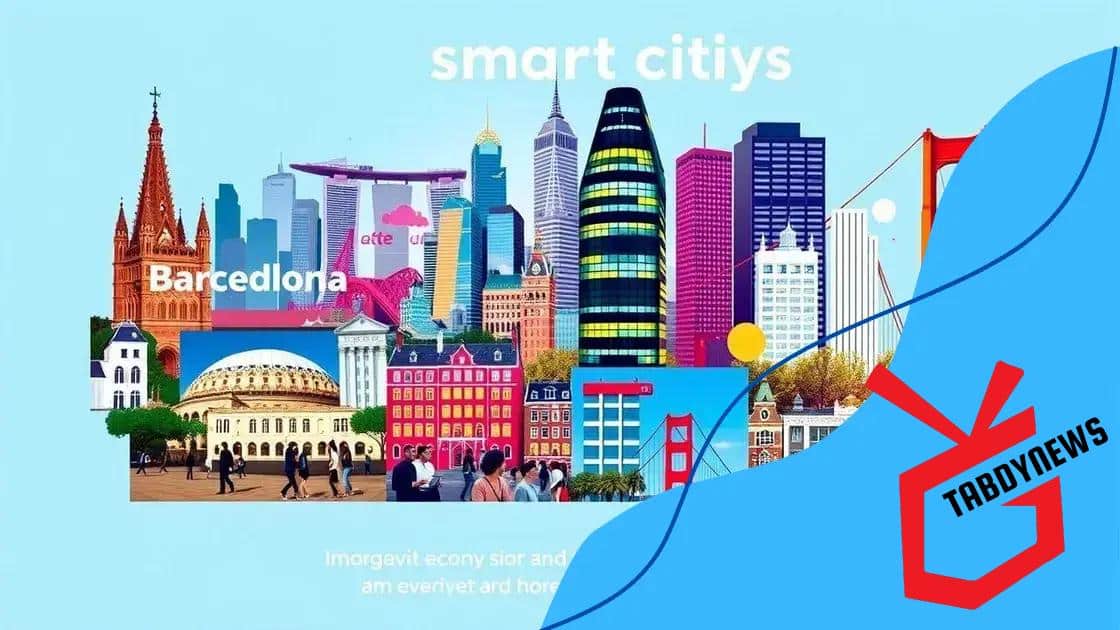Smart city technology and citizen engagement: a new era

Smart city technology enhances citizen engagement by utilizing data, AI, and connectivity to improve urban living, optimize services, and foster active community participation.
Smart city technology and citizen engagement are reshaping the way we interact with our urban environments. Have you ever wondered how your city could improve efficiency and engagement through technology? In this article, we’ll delve into this exciting transformation.
defining smart city technology
To understand smart city technology, we first need to know what it encompasses. Smart cities use digital technology to enhance performance, address public issues, and improve overall quality of life. As urban areas grow, it becomes essential to innovate how we manage resources, services, and citizen engagement.
Key Components of Smart City Technology
Smart city technology integrates various components to create a seamless urban experience. Let’s explore some of these crucial elements:
- Internet of Things (IoT): Devices connected to the internet collect data and communicate in real-time.
- Big Data: Large volumes of data from various sources help make informed decisions.
- Sustainable Energy Systems: These systems utilize renewable energy sources to minimize environmental impacts.
- Smart Transportation: Innovative traffic management and public transit solutions reduce congestion.
Each of these components plays a vital role in shaping the modern cityscape. By leveraging technology, cities can streamline operations and engage with their residents.
Another vital aspect of smart city technology is the focus on citizen engagement. Providing residents with the tools to interact with their city fosters a sense of community and enables feedback. For instance, mobile apps allow users to report issues, suggest improvements, and stay informed about local events.
Real-World Applications
Various cities around the globe have successfully implemented smart technology. For example, Barcelona uses sensors for monitoring air quality and traffic flows. This data helps the city optimize its resources and enhance the living environment for its inhabitants. Similarly, Singapore has developed a comprehensive smart transport system that provides real-time updates for commuters.
As these technologies advance, the potential for even greater citizen involvement continues to expand. In the coming years, we can expect smarter solutions to improve urban living.
how citizen engagement drives smart city success
Citizen engagement is essential for the success of any smart city initiative. It fosters a sense of community and ensures that residents feel included in decision-making processes. Engaged citizens are more likely to contribute feedback and suggestions, which can help streamline services and improve urban living.
Benefits of Citizen Engagement
By actively involving residents, cities can identify the needs and desires of the community. This connection leads to better solutions that serve the population effectively.
- Improved Services: Engaging citizens allows for the identification of gaps in services, leading to enhancements that benefit everyone.
- Increased Transparency: Open communication fosters trust between the city government and residents, creating a collaborative environment.
- Stronger Community Bonds: Active participation helps build relationships among residents, encouraging a supportive network.
- Data-Driven Decisions: Through feedback and data collection, cities can make informed choices that align with community needs.
When citizens feel their voices matter, they are more likely to participate in initiatives that enhance their surroundings. Examples include attending town hall meetings or contributing to online forums. The use of technology simplifies this process, allowing for easier access to information and communication.
Innovative Tools for Engagement
Smart cities often leverage technology to boost citizen engagement. Mobile apps, social media platforms, and interactive websites provide avenues for residents to engage with local authorities.
For instance, cities can utilize mobile applications that allow residents to report issues, such as potholes or broken streetlights, directly to city officials. This immediate feedback loop not only improves urban maintenance but also makes citizens feel valued as active participants in their communities.
Moreover, incorporating gamification elements into app designs can motivate residents to participate. By offering rewards or recognition for active engagement, citizens become more invested in the health of their city.
examples of successful smart cities

Many cities around the world have embraced smart city technology to enhance the quality of life for their residents. By implementing innovative solutions, these cities serve as examples of how technology can create more sustainable and efficient urban environments.
Barcelona, Spain
Barcelona is a leading example of a smart city. The city utilizes IoT devices to monitor traffic, improve air quality, and manage public services. For instance, its smart lighting system adjusts brightness based on real-time pedestrian usage, saving energy and reducing costs.
Additionally, Barcelona’s mobile apps allow residents to report issues directly to the city council and receive updates on local initiatives. This has fostered a strong sense of community involvement.
Singapore
Singapore has transformed into a smart city through its comprehensive approach to urban planning. The city uses data analytics to manage its traffic flow and public transportation effectively. The Land Transport Authority collects data from transportation networks to optimize routes and reduce congestion.
Moreover, Singapore’s smart parks integrate technology into green spaces where citizens can enjoy nature while also participating in environmental monitoring through mobile applications.
Amsterdam, Netherlands
Amsterdam showcases how smart technology can foster sustainability. It employs a variety of initiatives, including smart energy grids and bike-sharing programs. The city collects data to improve cycling infrastructure, ensuring a safer experience for cyclists.
Furthermore, Amsterdam promotes public participation by involving residents in sustainability goals. Residents can track their energy consumption and receive tips on reducing waste, enhancing community awareness towards environmental issues.
San Francisco, USA
San Francisco is another successful smart city. The city uses sensors to manage waste in public bins, notifying maintenance teams when bins are full. This helps reduce operational costs and improve sanitation services.
Additionally, San Francisco offers various platforms for citizens to engage in urban planning discussions and submit feedback on proposals, ensuring that community voices are heard in city matters.
the role of data in citizen engagement
Data plays a crucial role in enhancing citizen engagement within smart cities. By collecting and analyzing information, cities can better understand residents’ needs and behaviors. This allows for targeted improvements in services and initiatives.
Types of Data Collected
Smart cities gather different types of data to facilitate engagement, including:
- Public Feedback: Surveys and questionnaires help gather resident opinions on various initiatives.
- Usage Data: Information on how citizens use city services guides enhancements and new offerings.
- Demographic Information: Understanding the community’s demographics helps tailor programs for different groups.
- Social Media Insights: Monitoring social media discussions allows cities to gauge public sentiment and respond to concerns.
Through this data, city officials can assess what services are most needed and how to improve interactions with residents. For example, if data indicates that public transportation is not being utilized, city planners can investigate why and implement changes to encourage use.
Benefits of Data-Driven Engagement
The integration of data into citizen engagement has several benefits. Firstly, it increases transparency, as residents are more informed about decision-making processes. Secondly, data allows for personalized communication with citizens, making them feel valued and heard. Furthermore, this approach can stimulate greater participation because citizens see that their input leads to real changes.
Data-driven tools, such as mobile applications, offer easy access for residents to share their thoughts and report issues. With real-time insights, cities can respond promptly and effectively to the community’s needs.
Ultimately, leveraging data supports a cycle of continuous improvement. As cities grow and evolve, ongoing data collection can help streamline services and keep citizen engagement at the forefront of urban development.
future trends in smart cities
The future of smart cities is filled with exciting possibilities driven by rapid technological advancements. As urban areas continue to grow, the integration of new technologies will reshape how cities function and engage with their residents.
Increased Use of Artificial Intelligence
In the coming years, it is expected that AI will play a larger role in managing city services. From traffic management to energy efficiency, AI algorithms can analyze vast amounts of data to optimize resource allocation. For example, smart traffic lights can adjust their timing based on real-time traffic patterns, reducing congestion and improving air quality.
Enhanced Connectivity Through 5G
The rollout of 5G technology will further enhance connectivity in smart cities. With faster and more reliable internet access, residents will benefit from seamless connectivity across devices and services. This high-speed network will enable the widespread use of IoT devices, enhancing data collection for informed decision-making.
5G also allows for real-time communication between city infrastructure and citizens. For instance, emergency services can receive critical information more quickly, improving response times during crises.
Focus on Sustainability
Future smart cities are expected to prioritize sustainability more than ever. As climate change becomes an increasing concern, urban planners will design green buildings and implement eco-friendly transportation options. Many cities are investing in renewable energy sources and smart waste management systems that contribute to a healthier environment.
Moreover, programs aimed at reducing carbon footprints, such as bike-sharing initiatives and electric vehicle charging stations, will become more prevalent. Involving citizens in sustainability goals will also be crucial to these efforts.
Citizen-Centric Technologies
As cities evolve, there will be a stronger emphasis on designing services with citizens at the center. Smart cities will continue to use data to create personalized experiences for residents. Mobile apps will offer tailored services based on user preferences and location.
Engagement platforms will allow residents to voice their opinions and participate in city planning, making them active contributors to their communities. This sense of ownership can foster a stronger bond between citizens and their city.
FAQ – Frequently Asked Questions about Smart Cities
What are smart cities?
Smart cities use technology and data to enhance services, improve sustainability, and engage with citizens more effectively.
How does citizen engagement improve smart cities?
Active citizen engagement ensures that residents’ needs are met and that they play a role in shaping their communities.
What role does data play in smart cities?
Data helps city officials make informed decisions, streamline services, and improve communication with residents.
What future trends can we expect in smart cities?
Future trends include increased use of AI, enhanced connectivity with 5G, and a focus on sustainable practices.





